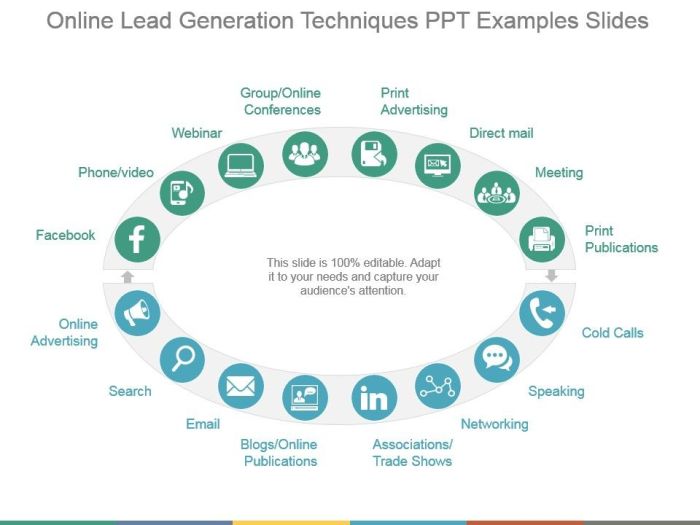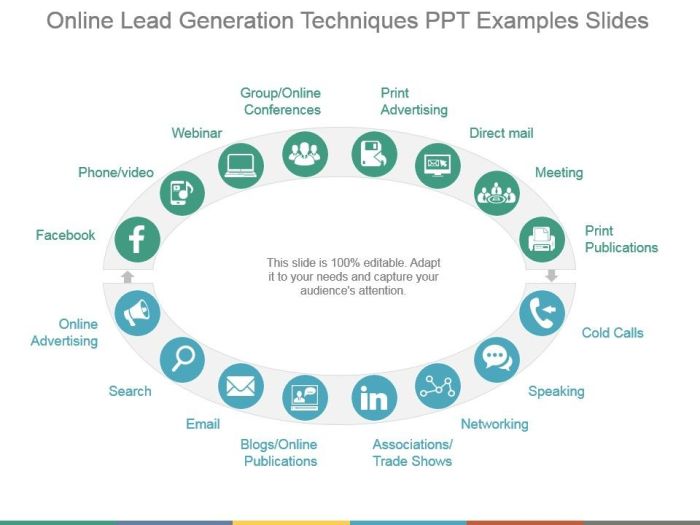Kicking off with Lead Generation Techniques, this paragraph dives into the world of attracting potential customers, breaking down successful strategies, and highlighting the importance for businesses in a high school hip style.
Lead Generation Techniques
Lead generation is the process of attracting and converting potential customers into leads, typically through various marketing strategies and tactics. The goal is to generate interest in a product or service and capture the contact information of individuals who have shown interest.
Examples of Successful Lead Generation Techniques
- Content Marketing: Creating valuable and relevant content to attract potential customers and encourage them to provide their contact information in exchange for the content.
- Social Media Marketing: Engaging with followers on social media platforms to build relationships and capture leads through targeted ads and posts.
- Email Marketing: Sending personalized and targeted emails to nurture leads and encourage them to take action.
- Search Engine Optimization (): Optimizing website content to rank higher in search engine results and attract organic traffic that can be converted into leads.
The Importance of Lead Generation for Businesses
Lead generation is crucial for businesses as it helps in identifying potential customers, nurturing relationships, and ultimately driving sales. By capturing leads, businesses can build a pipeline of interested individuals who are more likely to convert into paying customers. Additionally, lead generation allows companies to gather valuable data about their target audience, which can be used to tailor marketing strategies and improve overall business performance.
Inbound Lead Generation: Lead Generation Techniques
Inbound lead generation is all about attracting potential customers to your business through various marketing strategies, content creation, and providing valuable information to your target audience. This approach focuses on building relationships and trust with prospects, ultimately leading to conversions and sales.
Benefits of Inbound Lead Generation
- Higher quality leads: By providing valuable content, you attract prospects who are genuinely interested in your products or services.
- Cost-effective: Compared to outbound methods like cold calling, inbound lead generation can be more cost-effective in the long run.
- Builds brand authority: Consistent content creation and engagement help establish your brand as an authority in your industry.
- Long-term relationships: Inbound strategies focus on nurturing leads over time, leading to stronger, long-lasting relationships with customers.
Comparison with Outbound Lead Generation
- Inbound focuses on attracting leads through content and engagement, while outbound involves reaching out to prospects directly.
- Inbound is more about building relationships and trust, while outbound can be seen as interruptive and pushy.
- Inbound tends to have higher conversion rates and lead quality compared to outbound methods.
Effective Strategies for Implementing Inbound Lead Generation
- Create valuable content: Content marketing plays a crucial role in inbound lead generation. Focus on creating informative and engaging content that resonates with your target audience.
- Optimize for : Ensure your content is optimized for search engines to attract organic traffic to your website.
- Utilize social media: Engage with your audience on social media platforms to increase brand visibility and attract leads.
- Implement email marketing: Use email campaigns to nurture leads and guide them through the sales funnel.
- Offer incentives: Provide valuable resources, such as ebooks, webinars, or free trials, to capture leads’ contact information.
Outbound Lead Generation

Outbound lead generation involves reaching out to potential customers and initiating contact with them. The main objective of outbound lead generation is to proactively engage with prospects and generate interest in your products or services.
Examples of Outbound Lead Generation Techniques
- Cold calling: Reaching out to potential leads via phone calls to introduce your offerings.
- Email marketing: Sending targeted emails to prospects to promote your products or services.
- Direct mail: Sending physical mail, such as postcards or brochures, to a targeted list of leads.
Challenges Associated with Outbound Lead Generation
- Resistance from leads: Many prospects may be unwilling to engage with outbound marketing efforts, leading to low response rates.
- Compliance issues: Ensuring that outbound marketing efforts comply with regulations such as GDPR can be challenging.
- Cost: Outbound lead generation techniques can be expensive, especially when compared to inbound strategies.
Online Lead Generation
In today’s digital age, online lead generation has become a crucial aspect of marketing strategies for businesses of all sizes. With the vast reach of the internet, companies can leverage various online platforms to attract potential customers and convert them into leads.
Social media plays a significant role in online lead generation by providing a platform for businesses to engage with their target audience, build relationships, and showcase their products or services. Platforms like Facebook, Instagram, Twitter, and LinkedIn offer powerful tools for targeted advertising, content sharing, and lead generation campaigns.
Optimizing Social Media Campaigns
- Identify your target audience: Understand who your ideal customers are and tailor your content to resonate with them.
- Create engaging content: Develop high-quality, relevant content that provides value to your audience and encourages interaction.
- Utilize paid advertising: Take advantage of social media advertising tools to reach a larger audience and drive traffic to your website.
- Engage with your followers: Respond to comments, messages, and feedback to build relationships and establish trust with potential leads.
- Analyze and optimize: Regularly monitor the performance of your campaigns, track key metrics, and make adjustments to improve results over time.
Offline Lead Generation
In today’s digital age, offline lead generation techniques still play a crucial role in reaching potential customers who may not be easily accessible online. Traditional offline methods have been tried and tested over the years, proving their effectiveness in generating leads and driving sales.
Traditional Offline Lead Generation Methods
- Networking events: Attending industry conferences, trade shows, and local networking events can help establish connections with potential leads.
- Direct mail campaigns: Sending out physical mailers, brochures, and postcards to targeted audience segments can generate interest and leads.
- Telemarketing: Cold calling or warm calling potential leads can help in establishing direct communication and generating interest in your products or services.
- Print advertising: Placing ads in newspapers, magazines, and local publications can help in reaching a wider audience offline.
Effectiveness of Offline Lead Generation in the Digital Age, Lead Generation Techniques
Offline lead generation methods may seem old-fashioned compared to their online counterparts, but they still hold value in today’s digital age. In a world where digital marketing can sometimes feel impersonal, offline techniques provide a personal touch that can help in building trust and credibility with potential leads. Additionally, offline methods can reach individuals who may not be active online or who may prefer more traditional forms of communication.
Innovative Offline Lead Generation Techniques
- Host local events: Organizing workshops, seminars, or meetups in your community can help in attracting potential leads and showcasing your expertise.
- Utilize guerrilla marketing tactics: Creative and unconventional marketing strategies in public spaces can grab attention and generate buzz around your brand.
- Create referral programs: Encourage satisfied customers to refer their friends and family by offering incentives, discounts, or rewards.
- Sponsor local sports teams or events: Associating your brand with local activities can help in increasing brand visibility and generating leads within the community.
Lead Nurturing
Lead nurturing is a crucial aspect of the sales process as it involves building relationships with potential customers at every stage of the buyer’s journey. By nurturing leads, businesses can guide prospects through their decision-making process and ultimately increase conversion rates.
Importance of Lead Nurturing
- Lead nurturing helps establish trust and credibility with potential customers.
- It allows businesses to stay top-of-mind with leads, increasing the likelihood of a sale.
- By providing relevant and valuable information, lead nurturing can address the specific needs and pain points of prospects.
- Personalized lead nurturing campaigns can significantly improve engagement and conversion rates.
Lead Nurturing Strategies
- Send personalized follow-up emails based on a lead’s interactions with your website or content.
- Use marketing automation tools to segment leads based on their behavior and interests.
- Provide valuable content such as whitepapers, case studies, and webinars to educate leads.
- Engage with leads on social media platforms to maintain a connection and offer support.
Creating Personalized Lead Nurturing Campaigns
- Segment your leads based on demographics, behavior, and interests to tailor your messaging.
- Use dynamic content to deliver personalized recommendations and solutions to each lead.
- A/B test different messaging and content to determine what resonates best with your leads.
- Monitor and analyze the performance of your lead nurturing campaigns to make data-driven decisions for optimization.
Conversion Rate Optimization

Conversion Rate Optimization (CRO) is the process of increasing the percentage of website visitors who take a desired action, such as making a purchase or filling out a contact form. It involves analyzing data and user behavior to improve the overall performance of a website and increase the likelihood of converting leads into customers.
Best Practices for Improving Conversion Rates
- Optimize website design and layout for easy navigation and clear call-to-action buttons.
- Create compelling and relevant content that addresses the needs and pain points of your target audience.
- Implement A/B testing to experiment with different elements on your website and determine what resonates best with your audience.
- Use responsive design to ensure a seamless user experience across all devices.
- Personalize the user experience by segmenting your audience and tailoring content to their specific interests.
Role of A/B Testing in Conversion Rate Optimization
A/B testing, also known as split testing, is a method used to compare two versions of a webpage or app against each other to determine which one performs better. By testing variations of elements such as headlines, images, and call-to-action buttons, businesses can gather data on what resonates most with their audience and make informed decisions to improve conversion rates.
